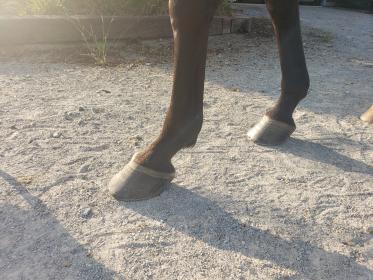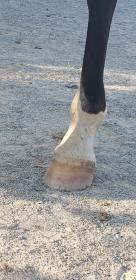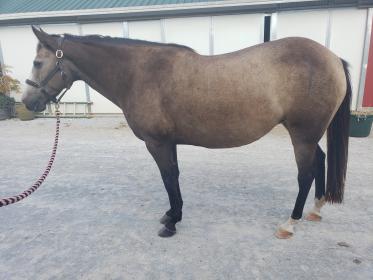Update:
We went back to the same vet yesterday. I wanted to get some xrays and discuss some things before I try to find time to haul her up to the other vet, and I figured we might as well just do the xrays here since I want to have some of her stifles, hocks and feet anyways.
He did some flexions again to see if there was any change. We lunged her first, right hind was short. Fine on the straight after flexing. But interestingly enough, this time after he flexed her left hind, while she was okay on the straight you could tell she was more off left hind on the lunge both ways. Which he had noted last time that after we blocked her feet, she was more off on the left hind (I was having to lunge her last time because she was being a bit of the devil incarnate so I didn’t get to focus much).
He mentioned though that the way she moves just makes it all really confusing. She doesn’t drag her toes, she doesn’t land toe first but lands quite solidly on her whole foot evenly on both sides. She isn’t flexing much on the left hind. She kind of steps out. The only way you can tell she isn’t 100% is her hip hiking up a bit more on the left and not flexing as much, and her right not tracking all the way up going on a circle to the left. Xrays were all clean, minus a little hook on her left stifle that he doesn’t think should be enough to cause anything. He said that if we did decide to block her, he wants to take a day to hook her up to the lameness locator so we can get a baseline to compare any differences to, just because she is so weird and stoic that he thinks it might be more difficult with her to tell when something helps.
She has a nice lump on her right hip that I pointed out (hadn’t though much about it last time), that she was iffy about him pressing into, that he says appears to be an old muscle tear. He doesn’t THINK that would be causing the short stridedness, but it’s possible. She is also very very tight on all the muscles on that leg. I got the videos of her being ridden and worked right before she went to the new lady, and he agreed that she looks 100% there, so there was definitely something that happened right after she was sold.
So, our current plan of action is to try bringing her lightly back into work, no circles, just walking long and low, try to stretch and relax those muscles. My equine massage therapist friend is coming out next week to work on her too, which he thinks is a good idea. If she appears to get worse, obviously stop the light work, and if she doesn’t get better or doesn’t change at all by a week after the massage, he wants us to come back and try the lameness locator and blocking. So we can do that, or go up to the vet in TN. Leaning towards the vet in TN just because my farrier is really wanting me to take her up there, but I want to give relaxing and stretching those muscles a chance to work first (and my bank account a couple weeks to breathe).
On the bright side though, her temperament is so much better. She isn’t randomly spooking and bolting, she is much more relaxed and happy, back to the horse she used to be. The vet and techs all commented on how much happier she seems now. She is slowly losing weight too (obviously don’t want it to drop too fast). Her feet all look great now. She is coming up to me shoving her face in her halter begging me to do stuff with her. That, at least, is all very encouraging.




 He was also chubby. :o
He was also chubby. :o
